People often ask us, “What should we do to drive sales success?”
It’s a complicated question. You’ll need to consider the following factors, among many more:
- What to tackle
- When to tackle it
- What results the organization should be targeting
- Where you can get the biggest bang for your buck
- What it really takes to get those results
This kind of analysis stymies many a company leadership team. Walk into any conference room after a sales strategy meeting and you might find something like this on the white board:

When we began analyzing sales teams years ago, we saw the need for an organizing framework to cut through all the complexity and provide a lens to view sales organizations with a clear eye. The result: the Sales Performance Wheel.
The Sales Performance Wheel provides a broad understanding of the 8 drivers of sales performance. We can then use these as the basis for leading a sales performance analysis and ultimately plan a strategy for better results in your organization.
A Framework for Sales Performance Analysis: The Sales Performance WheelSM

Based on decades of sales research and behavioral science, the Sales Performance Wheel is a guide to help leaders analyze where they are now, where they need to be, and how best to get there. The Wheel has been the central model in hundreds of sales organization performance analyses.
The Sales Performance Wheel categorizes the various influences on sales success into eight buckets. The first four concern the organization itself and the performance environment for its sellers. The second four categories relate directly to sellers and sales managers. Our research on what the best sellers and sales managers do differently offers a closer look into the individual factors that influence success.
The 8 Drivers to Improve Sales Performance
- Strategy focuses on the factors that most affect the direction of the sales organization. To achieve long-term success, leaders must develop a strong overall strategy, streamline it, and execute it. You can take all sorts of action, but without the right strategy and leadership, it may simply be, as Sun Tzu said, the noise before defeat.
- Structure relates to the organization of selling at the company, including sales compensation, territory design, and territory, account, and lead assignment. If you don’t get the structure right, you might not attract or keep the right people, and you leave significant revenue-growth opportunity in the market untapped.
- Operations refers to how efficiently the sales organization runs, how activities and outcomes are tracked, and how information is communicated to management for decision making. Without a good handle on operations, sales organizations are inefficient and cost too much. Leaders have no visibility into how the organization is doing or what metrics need to change to drive performance higher.
- Enablement is what allows sellers to sell at their potential, including sales management and coaching, sales process, sales method, and all technologies, tools, and resources. Where lack of operations makes sales organizations inefficient, a lack of enablement ensures sales organizations are much less effective than they could be.
- Talent Management is the organization’s overall strength of people, including the competencies of sellers and sales managers, recruiting, selection and assignment, and onboarding. Sales organizations need the right people in the right roles to succeed.
- Training focuses on the development of sellers and the organization’s culture and investment around training and education. It includes effectiveness overall and in specific areas such as filling the pipeline, driving opportunities, driving account growth, and managing sellers. Sales teams need the skills to be able to succeed. Without effective training, they don’t get them, and results suffer.
- Capabilities refers to the skills needed to drive sales performance, such as filling the pipeline, driving opportunities, developing executive relationships, consultative selling, managing sales, growing accounts, and more. Sellers need these skills to succeed, but many have significant skill deficits.
- Motivation includes seller attitudes, their energy and focus, leadership’s ability to create and sustain selling energy, and the organization’s culture with respect to selling. To optimize your sales force, you need to have a highly motivated team bringing their “A game” day in and day out.
These 8 categories are all deeply interrelated. Many leaders look for that one thing they should be doing to drive sales success, but there’s no silver bullet. The secret is in finding the right mix of relevant factors that will drive your results to the next level.
Next, you’ll need to learn where you excel and where you can improve to develop a strong sales performance improvement strategy.
GET THE LATEST SALES TIPS, TOOLS, AND RESOURCES
Subscribe today to get the latest on virtual selling, insight selling, strategic account management, sales conversations, and more straight to your inbox.
How to Analyze Sales Performance
Sales performance analysis is a complex process. It’s no easy task to figure out how to improve, change, or build a sales strategy. However, it’s necessary for sales leaders looking to optimize sales performance.
Sales performance optimization doesn’t happen overnight, often taking quarters or years. It’s an odd fit in the world of selling, where the line of sight rarely extends beyond the end of the current quarter.
Even so, this longer-term view tends to generate outsized returns, much like the Warren Buffet-led Berkshire Hathaway. In the Harvard Business Review article, “What It’s Like to be Owned by Berkshire Hathaway,” a key takeaway is that leaders are encouraged to take a long-term view of investing in their business to gain a competitive advantage, saying, "A long-term investment horizon improves operating performance."
Unfortunately, short-termism is rampant in sales.
In one RAIN Group Center for Sales Research benchmark report, we presented a list of 19 challenges to sales and strategic account management leaders. The number one most prevalent challenge faced by 58% of average and below-average performers: "Pressure to focus on short-term vs. long-term results."
For those leaders willing to pull their noses out of this week’s pipeline report and take a long-term view of sales performance optimization, the next step is to lead a sales performance analysis. After all, if you don’t know where you are, it’s tough to figure out where you want to be and how to get there.
For any sales performance analysis you run, consider the following 9 guidelines for getting the result that you need.
9 Guidelines for Leading a Sales Performance Analysis
- Define the specific impact you seek to achieve. Higher win rates? Faster revenue growth? Lower turnover? Lower cost of selling? Higher quotas? Better pricing and margins? Faster ramp-up? Stronger hiring? Something else? For any of these, be specific about what you intend to achieve and the financial impact.
- Include input from all stakeholders that somehow touch the selling process, from sellers, sales managers, seller/doers, marketing, operations, leadership, delivery, etc.
- Make the process collaborative. Beyond just gathering input from others, work together to build the strongest possible analysis plan—that is, if you want the best data and you want the best chance of an implementation that succeeds.
- Combine survey analysis with consulting analysis. You can learn a lot from survey data, but it’s the combination of survey data with expert analysis that yields the most insight.
- Benchmark your company against other companies. It’s not good enough to know where you are. You need to know where you are compared to others to have a sense of where to focus your efforts to get the best results.
- Know that most sales performance optimization efforts require a significant amount of change. Most people underestimate the amount of effort it will take to make the changes happen. Don’t let this deter you.
- Define and prioritize key initiatives that will take time and effort and low-hanging fruit that you should change quickly.
- Don’t assume technology will fix it. Many organizations rush to the latest and greatest sales technology implementation to solve their sales ailments. Create the strategy first before choosing technologies to help drive performance. Technology can enable sales performance, but tends to play a supporting role, not a lead.
- Create a specific action plan with goals, tasks, costs, schedules, and accountabilities. Without a plan you can trust, sales performance optimization efforts tend to stall.
Sales Performance Strategy
Driving sales performance improvement at your organization requires examination of all sorts of tactical areas, from people and training to enablement and operations. None of these address the fundamental questions: where are we going? What are we doing to achieve our goals? Who will lead us there?
The Strategy category of the Sales Performance Wheel focuses on the factors that most affect the direction of the sales organization.
5 Components of Sales Strategy
-
Go-To-Market Strategy: Every sales organization has a direction, but it might not be the right one. Sales leaders must make conscious decisions about how they drive value for their market, how they generate revenue, how sales, marketing, and delivery operations work with each other, why they win and grow, and their expectations for what the sales organization needs to do to bring their vision to life.
-
Value Proposition: When we say “value proposition,” we don’t mean in the sense of an elevator pitch. We mean, from a strategic perspective, what value the overall organization brings to the table. This area also covers your competitive position. You need a firm understanding of why buyers buy, and why they buy from you.
-
Priorities: Every sales organization has priorities. The question is whether they have the right priorities, the right plan to execute those priorities, and the right leadership and team to execute them.
According to our research, 69% of Top-Performing Sales Organizations prioritize improving sales force effectiveness. Only 57% of The Rest do. Further, only 51% of The Rest agree that “when company leaders set a priority, the priority gets done.”
-
Pricing Strategy: Organizations must make numerous pricing strategy decisions. Some organizations discount because they must, and some do so intentionally as a part of a larger plan. Some seek to achieve premium pricing, while others are content with market rate. Some pursue high pricing to build strategic competitive advantage. Some pursue low pricing for the same reason.
58% of Top Performers agree that “our pricing strategy allows us to capture maximum prices in line with the value we provide,” compared to only 41% of The Rest. Regardless, you need to define the best possible pricing strategy for your organization.
-
Leadership: Who leads the sales organization, with what styles, how they collaborate with the rest of the organization, and how they collaborate and communicate with the sales team are all critical factors in sales efficacy and optimization. Without strong leadership, even the best sales strategy will fail.
The tactical steps you take to improve sales performance should all be informed and guided by a strong sales strategy and sales leadership.
4 Keys to Improve Sales Performance
With all of these factors in mind, what actually separates Top-Performing Sales Organizations from The Rest? To find out, the RAIN Group Center for Sales Research gathered data from 472 respondents representing companies with sales forces ranging in size from 10 sellers to 5,000 plus and published the results in the Top-Performing Sales Organization Benchmark Report.
We considered the following when defining Top Performance:
- High win rates
- Meeting annual sales goals
- Whether or not sales goals were challenging
- Capturing maximum prices in line with value provided
The Top Performer group represents the top 20% of respondents to our study.
One surprising finding is just how much higher Top Performer win rates (from proposal to close) are compared to The Rest: 62% vs. 40% respectively. This represents a 22-percentage point difference. Even incremental improvements in win rate have a dramatic impact on revenue and profitability.
The following four factors are among the most important when it comes to increasing win rates, beating sales goals, and improving performance—in other words, striving to be a Top-Performing Sales Organization.
1. Become a Value-Driving Sales Organization
Top Performers are much more likely to focus on driving maximum value for their customers than The Rest (81% versus 61%, respectively). Those companies that are Value-Driving are much more likely to grow revenue, have higher win rates, and have lower undesired sales turnover (i.e., they’re able to retain top sales talent).
Value makes a difference. The organizations that can create and deliver value, align their structures and processes to do so, and invest in sellers’ ability to be more valuable to their buyers get better results.
2. Optimize Your Sales Process and Opportunity Management
Optimizing your sales process and improving sales opportunity approach are two key priorities for maximizing seller time and energy with their biggest opportunities. Top-Performing Sales Organizations are more likely to have mature sales processes than The Rest. Furthermore, 68% of Top Performers agree their sellers have the skills they need to drive and win sales opportunities, representing the highest sales skill area we asked about (only 50% of The Rest agreed).
Sales process and sales opportunity management exist to help sellers win sales. When companies have optimal processes for winning individual sales, their sellers perform better and win more often.
Download Optimizing Sales Opportunity Management: 12 Critical Questions Sales Leaders Must Ask. >>
3. Prioritize Sales Skills Development and Training
Before we analyzed the data on the Top Performers, we assumed that stronger sales skills would correlate with better performance. Not only was this assumption correct, we were surprised by just how large the gap is between Top Performers and The Rest across sales skills. In each of the nine sales skill areas we studied, Top Performers are significantly more likely to have the sales skills they need to succeed.
Furthermore, we found a significant correlation between sales training maturity, effectiveness, and investment to higher seller skill levels.
We also found sales training investment and effectiveness significantly impact seller motivation and attitude. When sellers believe their organization is investing in them, they’re more confident in themselves when selling and more motivated to achieve top performance. The end result: you get a team selling with hustle, passion, and intensity consistently over the long-term.
4. Take the Lead
We now know that improvements in key areas of the sales organization will drive win rates higher. But you’ll need to identify multiple areas of focus. Based on our findings, most organizations have a lot of work to do to reach the top. For any kind of change initiative, leadership needs to take control.
Interestingly, more than half (57%) of The Rest already prioritize improving sales performance. However, Top Performers are much more likely to achieve their priorities once they’re set (69% vs. 51%). When sales leaders provide the structure and support necessary to improve sales performance, it’s easier for sellers to focus on their own improvement.
Committing to Sales Performance
The leaders and organizations that prioritize sales performance improvement make the right choices on where to focus, invest in their sellers, and achieve their goals.
It’s an ongoing process, but planning and consistency pays off, enabling you to stick with a strategy that will transform your team and boost your sales performance.







